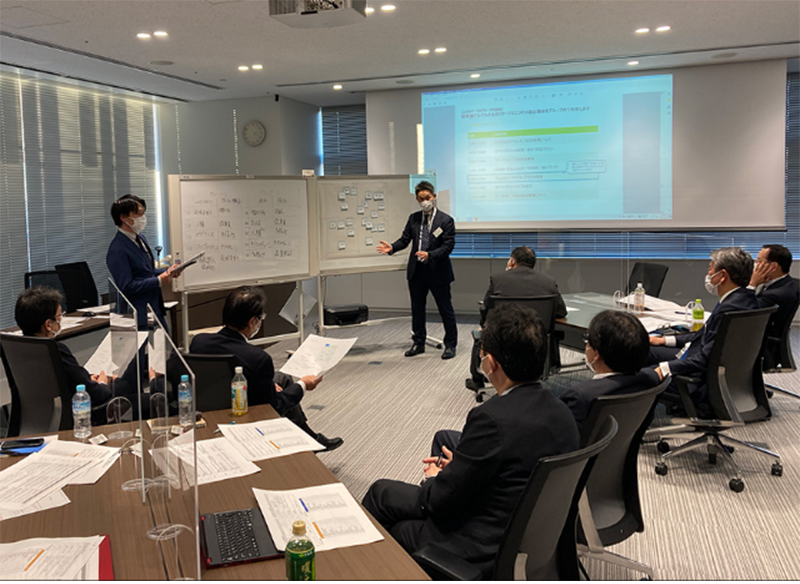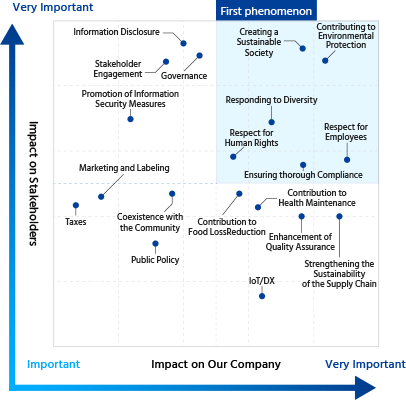Materiality of Toyo Seikan Group


For the purpose of contributing to the realization of a sustainable society, Toyo Seikan Group has designated Materiality of Toyo Seikan Group as the top priority issue. We set the new materiality with six key issues described below.
*The table can be scrolled left or right.
| Materiality | Risks and Opportunities | KGI | Target FY | FY2023 results and initiatives |
|---|---|---|---|---|
|
Developing and offering products and services that support various lifestyles Aiming to achieve one of the pillars of Long-Term Management Vision 2050: “Responding to diversity,” we will provide products and services that focus on diversified lifestyles and needs of consumers and thereby contribute to resolving social issues. |
Risks
Opportunities
|
Sales ratio of certified products and services of 30% or greater |
2030 |
19.6% |
|
Developing and offering products and services that are environmentally sound Aiming to achieve one of the pillars of Long-Term Management Vision 2050: “Creating a sustainable society,” we will provide products and services that support environmental protection and thereby contribute to resolving social issues. |
Risks Loss of trust from stakeholders and competitiveness against rivals due to delays in developing and offering environmentally sound products and services Opportunities
|
|||
|
Contributing to environmental protection We will implement various initiatives to reduce environmental impact for the realization of a zero-carbon, zero-waste society that coexists with nature, which is the goal we set in Eco Action Plan 2030. |
Risks Less competitive advantage due to delays in addressing environmental issues, such as GHG emissions reduction and resource recycling Opportunities
|
GHG emissions from operations (Scope 1 and 2) 50% cut (vs FY2019) |
2030 |
18.9% reduction (vs FY2019) |
|
GHG emissions from supply chain (Scope 3) 30% cut (vs FY2019) |
2030 |
6.7% increase (vs FY2019) | ||
|
Use of exhaustible resources 30% cut (vs FY2013) |
2030 |
20.4% reduction (vs FY2013) | ||
|
Use of fossil resources for plastic products 40% cut (vs FY2013) |
2030 |
19.7% reduction (vs FY2013) | ||
| 1% improvement per unit of sales from the previous fiscal year |
2030 |
6.0% improved | ||
|
Respect for human rights We will ensure that there is no discrimination, forced labor, harassment or abuse or any other human rights violations in the Group as well as in the entire supply chain and will prevent such violations. |
Risks Lower reputation and sales resulting from disputes and protests on human rights issues Opportunities Ensuring stable procurement by respecting human rights across the supply chain |
Implementation rate of human rights due diligence in the Group 100.0% |
2030 |
|
|
Implementation rate of supply chain due diligence in the Group 100.0% |
2030 |
The Self-Assessment of CSR Procurement Guidelines, conducted in advance in FY2022 by the Company’s Procurement Division, expanded to 28 major group companies and newly involved 1,258 suppliers. | ||
|
Implementation rate of educational program for human rights in the Group 100.0% |
2025 | E-learning program using materials based on the UN “Guiding Principles on Business and Human Rights” and other related frameworks was taken by 4,599 persons at 39 companies in Japan. | ||
|
Respect for employees We will build a rewarding work environment that cares about the health and safety of employees and their diversity and will secure and develop talent who will continuously take on challenges for new value creation, thereby aiming to maintain and boost our competitiveness. |
Risks
Opportunities
|
Ratio of female managers*1 Higher than 6% |
2030 | 4.4% (as of April 1, 2024) |
|
Ratio of female hires*1 Higher than 30% |
2025 | 17.5% | ||
|
Male-female difference in average years of continuous employment*1 3 years or less |
2025 |
3.1 years (males: 18.3 years, females: 15.2 years) (as of March 31, 2024) |
||
|
Retention rates both for male and female workers who were hired between 9 to 11 years ago*1 Higher than 70% |
2025 |
Males: 62.3%, females: 50.5% (total 60.5%) (as of March 31, 2024) |
||
|
EBITDA per employee*2 5,500 thousand yen or more |
2025 | 4,540 thousand yen | ||
|
Employee engagement*1,3 52.7 or more |
2025 | 50.8 | ||
|
Awareness of the Group’s philosophy and vision*1,4 80% or more |
2025 | 51% | ||
|
General health risk*1,3 100 or less |
2025 | 103 | ||
|
Workplace with growth opportunities*1,3 52.9 or more |
2025 | 51.8 | ||
|
Percentage of key personnel with work experience at other group companies*1 60% or more |
2025 | 59.1% | ||
|
Number of workers whose monthly overtime exceeded 45 hours*1,5 2.7 persons |
2025 | 5.0 persons | ||
|
Ensuring thorough compliance We will ensure compliance with laws and regulations, corporate ethics, and norms and take preventive measures against corruption and anti-competitive behavior. |
Risks Underperformance of operations, loss of social trust, and damage to corporate value due to noncompliance activities Opportunities
|
Compliance with laws and regulations, corporate ethics, and norms |
- The seven Group companies are: Toyo Seikan Group Holdings, Ltd.; Toyo Seikan Co., Ltd.; Toyo Kohan Co., Ltd.; Tokan Kogyo Co., Ltd.; Nippon Closures Co., Ltd.; Mebius Packaging Co., Ltd.; and Toyo Glass Co., Ltd.
- The amount is calculated by dividing consolidated EBITDA by the consolidated number of employees.
- We use the HoPE Survey, which is provided by HOKENDOHJIN-FRONTIER Inc. “Workplace with growth opportunities” is an indicator to determine whether a workplace empowers employees to envision their own career paths and future growth and to engage in work independently and proactively.
- This indicator shows the percentage of employees who answered, in the HoPE Survey, that they “understand” or “understand to an extent” the Group’s philosophy and vision.
- This indicator is the average of the monthly number of workers who fall in this category per 100 workers for each fiscal year, calculated excluding managers.
Materiality Identification Process
Identification of Issues
- Toyo Seikan Group drafted a long list of issues requiring attention based on the guidelines of the Global Reporting Initiative (GRI) and Sustainability Accounting Standards Board (SASB) as well as the Mid-Term Management Plan 2025 and industry issues.
- A list of 19 topics was drafted by consolidating and integrating similar issues.
Prioritization
- The importance of each issue to the Toyo Seikan Group was carefully examined, taking into consideration consistency with our management philosophy and the Group's Code of Conduct and Guidelines of Behavior, as well as evaluations of each issue at workshops held with officers from operating companies.
- The importance of each issue to stakeholders was carefully examined, based on a range of information including the key issues present in the packaging industry, key ESG topics institutional investors pursue with companies, and more.
- Candidates for materiality for the Toyo Seikan Group were identified.

Identification of Materiality
- Outside experts reviewed and validated the identification process and materiality candidates generated.
- Materiality for the Toyo Seikan Group is identified through resolution processes at the Board of Directors.
Materiality Matrix

Materiality of Toyo Seikan Group
- Developing and offering products and services that support various lifestyles
- Developing and offering products and services that are environmentally sound
- Contributing to environmental protection
- Respect for Human Rights
- Respect for Employees
- Ensuring thorough compliance
"Climate Change," "Contribution to the Environment through Efficient Resource Use," and "Biodiversity" as Integrated Themes
Materiality Assessment and Review
Each year, the Sustainability Committee conducts a progress report and assessment of its materiality to facilitate the Company’s plans to drive sustainability initiatives with results and to make sustainability-based improvements to corporate value. The results of the progress report and assessment by the Sustainability Committee are reported to the Board of Directors, which verifies the validity. Also, for each period corresponding to the term of the Mid-Term Management Plan, a review is conducted of the material issues. Based on this, the business strategy and the sustainability initiatives are always kept up to the latest status in response to changes related to society, the environment, and business.
Toyo Seikan Group's Initiatives to Address the Material Issues in Relation to the SDGs
We have been providing a variety of products and services that contribute to the UN Sustainable Development Goals and engaged in sustainability initiatives.
To advance these efforts, we have organized major targets under each of the key ESG themes, identified material issues as our Materiality, and verified the relationship of our initiatives to address them with the 17 goals and 169 targets of the SDGs.
Address
the Material Issues in
Relation to the SDGs
Key Comments in Opinion Exchanges with Outside Experts

Executive Fellow, Research Institute of Capital Formation, Development Bank of Japan Inc.
Keisuke Takegahara
Graduated from Hitotsubashi University Faculty of Law in 1989. Joined the Japan Development Bank (now the Development Bank of Japan Inc. [DBJ]) later the same year. After appointments as Chief Representative for the Representative Office in Frankfurt, general manager of the Environmental Initiatives & Corporate Social Responsibility-Support Department, Head of the Economic & Industrial Research Department, and Executive Officer and Deputy Head of the Chief Research Office, he was appointed to his current position in 2021. He has been working for many years in the fields of environmental finance planning, including the creation of the DBJ’s environmental ratings-based financing program. He has held many public posts, including as a member of the Ministry of Economy, Trade and Industry’s Study Group on Disclosure Policies for Non-financial Information and the Ministry of Education, Culture, Sports, Science and Technology’s Study Group on Climate Change Research as well as a temporary member of the Ministry of the Environment’s Central Environmental Council. He has co-authored works including Renewable Energy and New Growth Strategy (Energy Forum Inc., 2015), and How to Tackle Climate Change Risk (Kinzai Institute for Financial Affairs, Inc., 2014), and others.
The materiality was selected as issues for addressing in the Mid-Term Management Plan 2025, itself a backcast plan from the Long-Term Management Vision 2050, “The Future, Wrapped for All,” which was formulated through extensive discussions among employees at all group companies. We can say this will play the initial steering role toward the goals of your long-term vision via the milestones of the Mid- to Long-Term Management Goals 2030, set along a solid timeline. There is a clear choice of three types of items: “offensive” areas targeting the Group’s goals in the long-term vision, like “developing and offering products and services that support various lifestyles” and “developing and offering products and services that are environmentally sound,” then “defensive” areas where negative impacts should be avoided in relation to achieving the former, like the environment and human rights, and then the fundamental elements like employees (human capital) and compliance. These processes have also been conducted with great care in a way that analyzes internal and external issues in detail, with deep involvement from management. As some of these concepts are highly abstract, my hope is that you will take further efforts in the selection of key performance indicators and instilling these with group employees in order to convince readers of the uniqueness of your company behind these, including the advanced level of your identification processes.


Chairman of the Board Global Compact Network Japan (GCNJ)
Toshio Arima
Graduated from the International Christian University College of Liberal Arts in 1967. Joined Fuji Xerox Co., Ltd. later the same year. He became the General Manager of General Corporate Planning in 1988, CEO of U.S.-based Xerox International Partners in 1996, President and Representative Director of Fuji Xerox in 2002, and Executive Corporate Advisor in 2008, retiring in 2012. During his tenure as president, amid his work in advancing management reform he also devoted his energies to CSR management, including pitching the idea of “corporate quality.” He was appointed as GCNJ's Chairman of the Board in October 2011. He also served as a member of the UN Global Compact (UNGC) Board from July 2007 until June 2018, and continues to work towards building a sustainable society to this day.
Your company has adopted an adequate and appropriate identification process for accurately determining materiality based on the guidelines of the GRI and SASB. Used packaging containers turn into enormous amounts of waste, causing issues for the marine environment. Your company's Long-Term Management Vision 2050, “The Future, Wrapped for All,” signals a business model transformation from being a packaging manufacturer to a “daily living platform.” Here, creating a circular economy for containers has not only social significance but also potential for new businesses, and I believe this should occupy a prominent position.
Although it has been mentioned before, I think this should be given more attention. Furthermore, the SDG Compass, a corporate action guideline for the SDGs jointly issued by the UNGC, GRI, and World Business Council for Sustainable Development (WBCSD), recommends an “outside-in” approach in which companies around the world step outside their own domains to address a wide range of global and social issues. In the sense that you will be able to maximally leverage your company's capabilities and explore new business opportunities, I would like to see you expand your scope further as you identify materiality going forward.